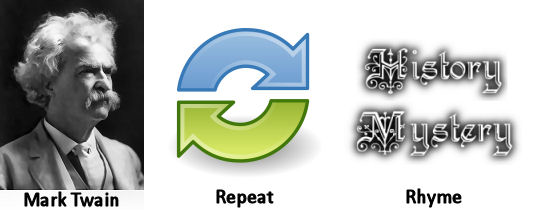Mark Twain? Theodor Reik? John Robert Colombo? James Eayrs? Anonymous?

Question for Quote Investigator: There is a popular humorous maxim about history that is usually attributed to Mark Twain. But there is so much uncertainty about this ascription that a top business columnist for the “New York Times” wrote the following:1
“History doesn’t repeat itself but it often rhymes,” as Mark Twain is often reputed to have said. (I’ve found no compelling evidence that he ever uttered that nifty aphorism. No matter — the line is too good to resist.)
Would you please research the provenance of this adage?
Reply from Quote Investigator: There is no substantive evidence that Twain who died in 1910 made this remark. Twain first received credit many years later in 1970, and details for this linkage are shown further below.
The earliest strong match known to QI appeared in 1965 within an essay by psychoanalyst Theodor Reik titled “The Unreachables”. The phrasing was a bit longer, but the meaning was the same. Boldface added to excerpts by QI:2
There are recurring cycles, ups and downs, but the course of events is essentially the same, with small variations. It has been said that history repeats itself. This is perhaps not quite correct; it merely rhymes.
Based on the citation above, QI tentatively credits Theodor Reik with formulating this saying.
Below are additional selected citations in chronological order.
Continue reading “Quote Origin: History Does Not Repeat Itself, But It Rhymes”